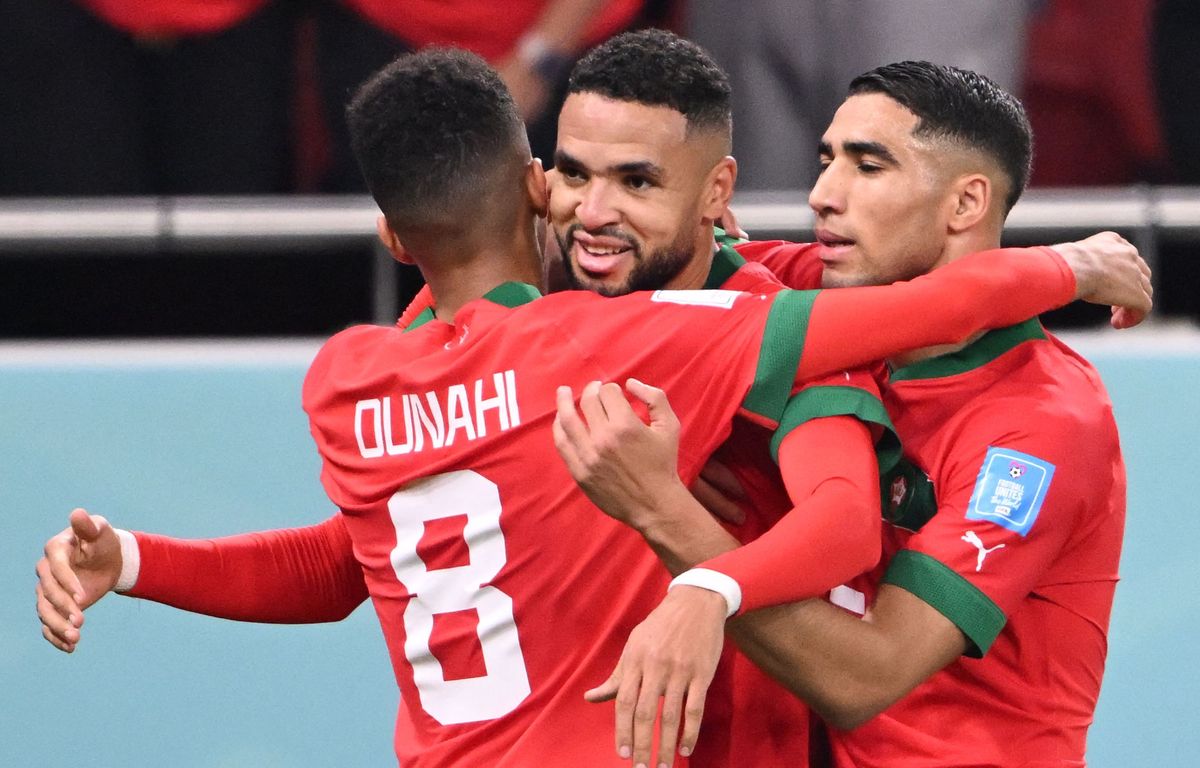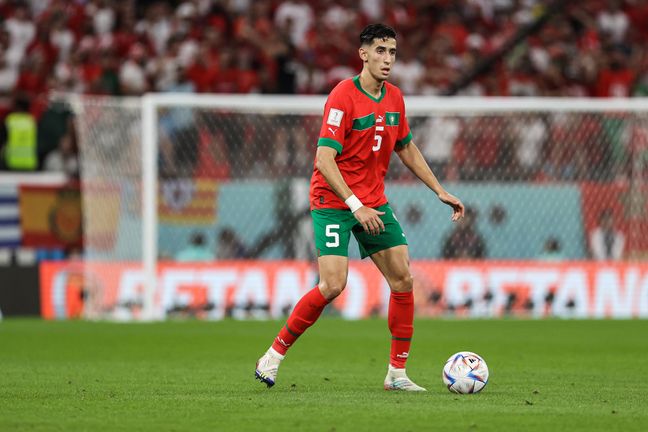Renewal of the Moroccan composition at the origin of this world of madness?

Achraf Hakimi’s Banenca, synonymous with his achievement against Spain in the Round of 16, quickly inspired his heirs. Just two days later, midfielder Houssem Elsedk (17) gave the victory to the Mohammed VI Academy, during the African Cup, by achieving the same gesture during the penalty shootout, in the final match against CNEPS Saadeh Thiess (Senegal). This prestigious under-19 tournament held in Agadir symbolically honored the Moroccan national team, which was crowned despite the presence of OGC Nice and Red Bull Salzburg or the Jean-Marc Guillou academies in Mali and Côte d’Ivoire. Meanwhile, 11 of the 26 Atlas Lions who will face France on Wednesday (8pm) in the World Cup semi-finals in Qatar, have been trained strictly in the country. Never has selection depended on such local representation in a major competition.
They include executives during massive repeat performances against Belgium, Spain and Portugal, starting with Yassine Bounou, the champion goalkeeper for Sevilla, who trained at Wydad from the ages of 8 to 21. There are also defenders Jaouad Al-Yamiq (formerly Khouribga and Raja Casablanca until the age of 26) and Yahya Atiyatallah (who still plays for Wydad), the decisive pass on Saturday against Portugal. Added to this list are former residents of the Mohammed VI Academy, Nayef Aghrad, Azzedine Onahi, and Youssef Al-Nusairi, who all underwent full training in Morocco before joining Europe. Many examples prove that this Moroccan selection does not depend only on the talent of dual nationals Sofiane Boufal and Romain Sayes (France), Sofiane Amrabat, Hakim Ziyech and Naseer Mazraoui (Netherlands), Salim Amal Allah (Belgium) and, of course, Achraf Hakimi (Spain).
13 million euros invested by King Mohammed VI
Enzo Jebali, former head of recruiting at Stade Reims, notes that “Morocco had already been working on his coaching for a short while. The Mohamed VI academy is its forerunner, and a realization of awareness: there was no reason in Africa for the academies of Jean-Marc Guilloux and the Paradou Sporting Club (Algeria) to come out of the best Players, not Morocco. Before managing the OM Training Center, King Mohammed VI elected Nasser Larqat in 2008 to carry out this pharaonic project, with a construction cost of 13 million euros. Technical director of this 18-hectare building until 2014 (with 8 football fields and a swimming pool and a weights room) located in the city of Sale (near Rabat), as explained by L 20 minutes Where was Moroccan football then.
At that time, we had lost a thread in Morocco: the country no longer trains players destined to join Europe. There was no continuity in seeing the training. We have been increasingly advocating for dual nationals to choose, including in youth groups. The clubs were only interested in the under-15 youth, when the main tournaments of the country started. Their priority was getting good results, not training. »
Add to that absences at the 2002 and 2006 World Cups (and then 2010 and 2014), and you will realize how quickly the urgency reached the ears of King Mohammed VI in the first decade of the 21st century. 9 years old, and the first promotion of the academy was born in September 2009, and Naif Ajord was already in its ranks. Of the 57 youngsters released during the four years with Nasser Larkut, 47 became professionals, and 12 joined European clubs.

Huge work “on the mental side”
Under-15 coach and position at the Mohammed VI Academy since 2010, Abdellatif Belmehdi presents the main focus of a training course “Not a copy of European supermodels”: “We want to train for the requirements of a high level, and for that, we work a lot on the mental side. In our sessions, the players must, for example, succeed in raising the score in a certain period of time, otherwise they must be able to resist as much as possible to play positions in numerical inferiority. Hey, just like the A did on Saturday during extra time in the quarter-finals against Portugal (1-0).
The Mohammed VI Academy also knows how to show its talents by participating in many tournaments in Africa and Europe. Last month, his under-19 team beat the under-19 national team in Strasbourg and Troyes, as well as the Valenciennes (N3) team during a tour of France. “Morocco has such a group of players and facilities, and not only in our academy, that these kids have nothing to envy to those who trained in France,” notes Boubacar Gadiaga, a French Senegalese who trained at OM and head of the performance division at the academy. There was One hundred scouts in the African Cup and we feel there is a lot of interest around our generation 2005, with seven players, in my opinion, for the top level. »

Strasbourg often recruits young players in Morocco
A good gathering does not leave the French clubs indifferent, as Strasbourg has used goalkeepers Alaa Bellaroche and Walid Hasbi for two years, as well as defender Anas Nana, all of whom trained in Sale. In 2018, the Alsatian club also brought in Azzedine Onahi, now known worldwide as darling Luis Enrique, but without offering him a chance in Ligue 1. For less than €500,000, the midfielder has since become one of the rare things that SCO satisfies the elite.
He could even bring a very large check to the club this winter. “We know that there are regions where we cannot be present because of our economic strength, like in South America, like in South America,” said Sébastien Larser, who was sports director in Angers at the time of this hiring. The players coached in Morocco. They are still inexpensive, and since there is no language barrier, their adaptation is easy in France. The potential has always been there in Morocco.”

Scouts who attend CHAN and Academy Championships
Sebastien Larser knows something about it, because he also contributed to the arrival of Naif Aguird to Dijon in 2018 (for 1.2 million euros), before he exploded at Rennes. French observers still abound at the CHAN, the African Nations Championship reserved for African players playing on the continent, in which Morocco has won the last two editions. Likewise, the Mohammed VI Academy tournament will attract eyes from all over Europe, as the local under-19 team will face Real Madrid, Atletico Madrid or between OM and OL.
The Lyon club also has the peculiarity that it bet on a partnership, at the end of 2019, with both Al-Fateh Al-Rabati (the first Moroccan club) and the Mohammed VI Academy. The two entities are run directly by the King’s government, explains Jean-François Follez, director of the OL Academy. These are the two most elaborate training projects in Morocco, so it was only natural to work together for the long haul, given our DNA. »
OL, the only French club to have entered into partnerships
Concretely, how is it an advantage for OL to be the only French club to have such an agreement in Morocco, while in three years only the left side Achraf Aziri (19), a trainee at Al-Fateh Rabat, has signed a professional contract in Lyon, without Lowest appearance so far in Ligue 1? Jean-François Follez, who travels to Morocco two to three times a year, explains: “The first objective is to share our expertise in order to create the most efficient training courses possible. Then, of course, it will be the culmination of a player who has trained in Rabat or at the Mohammed VI Academy to one day become a player.” A starter in Ligue 1. In this part of the recruitment process, we are informed about the players who are of interest. But we are not a priority: the players choose to join the project they want. »
Jean-François Follez admired these structures “worthy of a European training center, in terms of performance support and medical and scholastic control”, and in any case was not surprised by the saga of the Atlas Lions in this World Cup: “Given the resources that have been put into this training project, it makes perfect sense to me That Morocco has become the first African country to advance to the last four of the World Cup. The work is being done discreetly but in the long term, and the country is reaping the benefits today, as it may soon be the case in women’s football, which is developing a lot there.” And what if, in 2023, Morocco became the first African country to reach the quarter-finals of the Women’s World Cup since its first participation? After all, on the heels of the adventure of Walid Regragui and his family, this nation seems armed to all challenges.
#Renewal #Moroccan #composition #origin #world #madness





